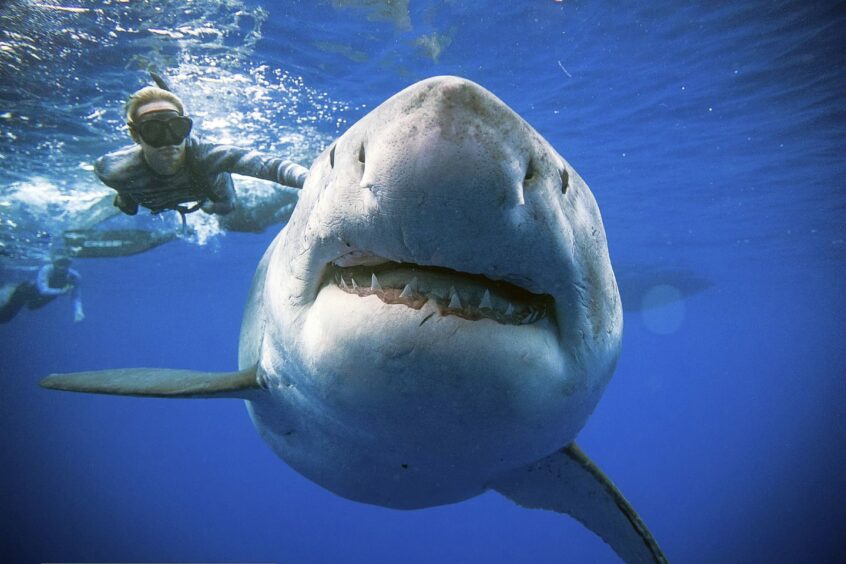I shared fake news and I am ashamed.
Awake in the small hours, I went to social media to see what was happening out there.
Someone had shared a post about a huge female Great White shark that developed a bond with a fisherman in South Africa after he had saved her from fishing nets two years before.
He even had a name for her – Cindy.
For real?
There it was, a picture of the fisherman, called Andre Potgieter in this story, and a monster Great White alongside his boat, allowing him to touch her belly.
She follows me around in the ocean, he allegedly said.
When I stop she comes up to the boat and allows me to pet her belly.
It was 3am and I was lying awake, wanting the world to be a nicer place.
I used to live in a fishing village and had heard stories from fishermen about sharks that knew the sound of certain fishing boats, they would follow them from the harbour.
In fact they would wait for them, knowing when they would go to sea.
Other boats they would ignore.
Can sharks feel emotions?
I idly Googled.
Yes, came the answer, they can.
They can feel happy and sad and depressed.
They are quite misunderstood creatures really, said various quoted scientists.
But as for this shark, I should have asked Snopes.
And so I shared the post. It got noticed by friends in different time zones, including my sharp friend in Canada, who did ask Snopes.
Fake news, came the answer
The story had emerged in South Australia too, in 2008.
The images – not all of the same shark, but how would you know – were real, taken from a PowerPoint presentation by two scientists who studied sharks.
The French magazine that first published the ‘Cindy’ story used those images when they published their story on April 1 2006.
‘Cindy’ was an April Fool’s joke.
Mortified, I took again to social media.
Fake news, I said. But people kept liking it.
I republished the Snopes article.
Sorry, sorry, but it’s not true, I wailed.
But they still kept liking it. We want to believe it, they said.
And that pretty much said it all.
Old newspaper tradition
Years ago, the April Fool story was a tradition on the big daily broadsheet where I worked.
Readers were in on it too, it was fun to spot the fake. If they could.
The finest minds in the newsroom would create the fake news.
The story would usually be buried away as a brief, as though it was something the newsroom had overlooked, something readers felt they had discovered themselves.
One year we published a story about a strange discovery at sea.
Fishermen had come across a man drifting on a wooden raft, wrapped in a burlap sack, all alone on the ocean.
They had hauled him aboard.
He was bewildered, he spoke a strange version of English, he was very, very old.
His clothes came from another time.
It was like he had arrived from the 17th Century.
Who was he?
Doctors on shore were baffled.
Our switchboard jammed. Thousands and thousands of calls.
Who was the man? Where did he come from? When will we have pictures?
The calls kept coming…
We published our standard April Fool’s identification the next day.
It was the April Fool’s joke, we said.
But the calls kept coming. For weeks, the calls kept coming.
They really wanted to believe the story of a strange man from another time.
Fast forward to today, where nearly everyone is a publisher.
Fake news spreads like wildfire in the echo chamber of what people believe, or want to believe.
There are many good things about the digital revolution, including that more people have access to information today than ever before.
But it’s equally true that it’s easier to curate your own reality.
You can simply believe what you want to believe and find plenty of ‘evidence’ to support it.
Legacy of Trump and Johnson?
In the United States, one of former president Donald Trump’s lasting legacies was sowing distrust in mainstream media – or rather, in news he didn’t like.
Add to this rise of AI generated ‘deep fake’ images, the rise of bots on the likes of Twitter, influencing opinions and even the outcome of elections, and you have a world where people don’t know who, or what, to trust.
Then again, if someone had told you even two years ago that Donald Trump and Boris Johnson would both be facing serious scrutiny by their respective governments in the same week would you have believed it?
Could you have foreseen Trump facing a real prospect of being arrested – and, as I write, deepfake images are circulating in the United States of his alleged arrest.
If you’d been told Boris Johnson’s political career may finally end over findings he misled parliament, would you have believed it?
Yet, it’s happening. And you could not make it up.






Conversation